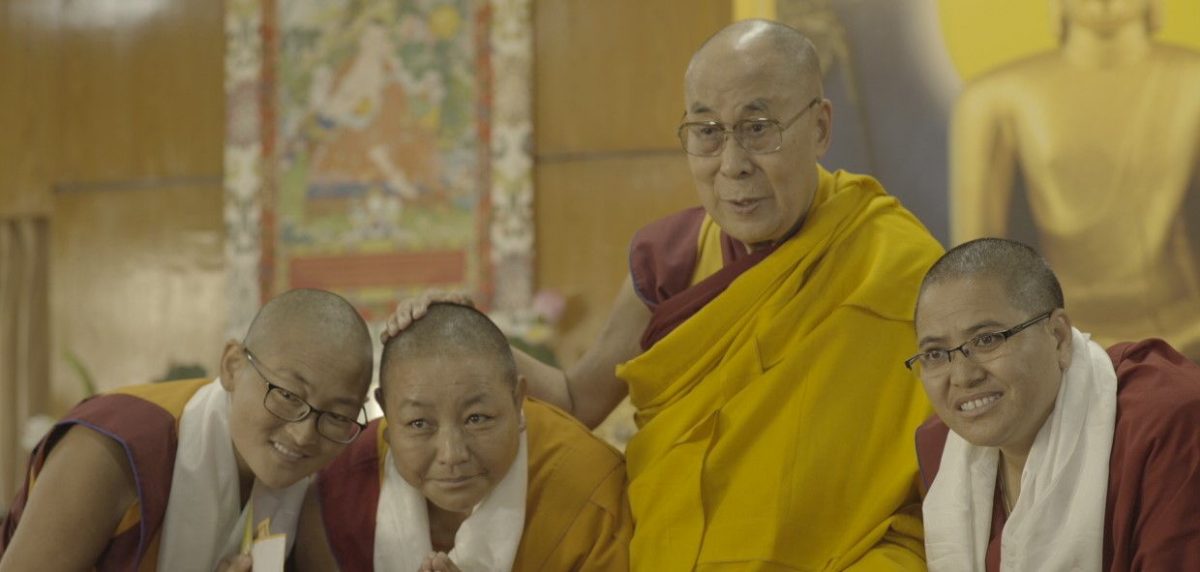What makes the 14th Dalai Lama, Tenzin Gyatso, the Tibetan Buddhists’ spiritual leader, stand apart from other temporal heads, is his firm commitment to reforms and accepting change as part of organic development of religion. This is vividly evident in the Public Service Broadcasting Trust’s one-hour documentary The Geshema Is Born.
Directed by Malati Rao, it traces how Tibetan Buddhist nuns who have sought equality for centuries, had their longstanding aspiration being fulfilled when they were conferred the highest monastic degree – the Geshema – in 2016 by Dalai Lama at Drepung monastery, Mundgod. Welcoming the historic conferment, the Tibetan political leader, Lobsang Sangay had said, “We owe His Holiness Dalai Lama a debt of gratitude.”
The event is singularly significant. Nuns were encouraged to pray and chant and there are examples of arahants (monks who have achieved enlightenment and passes to Nirvana at death) among them attaining liberation being in the female form. “Yet, education and the centres of learning like the Nalanda were only open to monks.” In 1979, when Dalai Lama escaped to India in 1979, a large number of monks and nuns followed him. One of the first decisions taken by the Tibetan government in exile when it came into existence was to set up centres of learning. “Preservation of their unique culture was critical to the exiled community,” says Rao.
Making a bold move then, the Dalai Lama recommended that nuns receive education as well, a change which was hard for a society whose very existence was endangered. “His holiness had the fortitude to see how important it was to bring gender parity,” observes Rao.
Change is hard to come by and definitely takes time. Gender parity in different faiths in India, too took years of struggle and now the can country boast of women Hindu and Christian priests and Muslim imam. Rao feels, women outnumber men when it comes to seeking spirituality in their lives. “I think it’s valuable for religious institutions to acknowledge this. Including women and giving them equal status is not only just but also a step to keep themselves relevant to those who are searching for answers. Every religion today is exploring its efficacy in the modern society.”
Praising the Buddhist nuns’ perseverance, Rao says, though the Tibetan Nuns Project was put into motion almost 25 years back, “the nuns of three generations have stood on each other’s shoulders to sustain the ideals of transformation and an end to suffering.”
The film brings to fore the opposition to this historic move. While Karma Gelek Yuthok, the Minister for Religion and Culture, Central Tibetan Administration in Exile remarks that Vinaya tradition forbids nuns, Geshe Rinchin Ngudup, a teacher feels that monks have better memory and debating skills.
“The fact that it took as long as it did clearly indicate that change was not easy,” avers Rao. Elucidating she explains, that in the origin stories, Buddha’s aunt Mahaprajapati asked him if she and other women could join the Sangha. He is said to have refused thrice before finally relenting. “This has been the main thrust of why women are second class citizens. This along with the fact that the Bhikshuni order cannot be traced to Tibet hence the women’s lineage is broken.” There were fears that Buddhism will not survive beyond 500 years once women were included; that it was against Buddha’s wishes; and that nuns cannot have the same discipline as the monks in the keeping the vows.
Do the misgivings still continue? “I think the fact that all the top leadership was present at the podium when the Geshemas got their degrees shows that there is now an agreement about the way forward.”
It is noteworthy that the nuns do not view gender equality as a mere civil or human right or the conferment of Geshema degree a tremendous achievement. They perceive it as a means to achieve spiritual salvation, nirvana. “The nuns are here to seek freedom from suffering. The Geshema degree is a triumph of them overcoming their fears and disappointments and paving the way to their future.”
Rao does well to capture the scenic beauty of the locales where the film was shot making the viewing a pleasant experience!




















